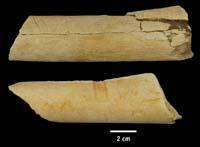The oldest remains of meat eating utensils in Ethiopia

In Ethiopia, in the Afar River region, a group of researchers has detected two fossilized mammal bones of about 3.4 million years ago, both with marks produced by a sharp stone instrument.
The journal Nature has released the discovery of the international team of anthropologists working on the research project Dikika. The study concludes that the species of the known Lucy (Australopithecus afarensis) ate meat almost a million years before what was thought so far and for it used stones.
It seems that the bones they have discovered are two large mammals. One of the bones can be part of the rib of a mammal the size of a cow and the other part of the femur of another mammal the size of a goat.
According to the researchers who have studied, the bones include cuts, breaks and blows. It is found that these marks were made before the fossilization of the bones and that, as for the morphology of the cuts, they discard that they could be caused by the teeth. Probably, therefore, the above marks arose trying to separate the meat from the bones.
So far, the oldest footprint or test was also found in Ethiopia, demonstrating the use of hominid stone utensils and meat consumption. In Bouri bones appeared 2.5 million years ago, also with cuts. And the stone openings of the same time have also been found in the area of Gona. However, scientists did not then find hominid fossils directly related to these bones and stones. Just 200 meters from its discovery in Afar, ten years ago they discovered the Selam, the child of Lucy.





